Pittsburgh, Pennsylvania (1860-1902)
This glass manufacturing firm began as Hale, Atterbury & Company in 1860. (Some sources have given 1859, but the 1860 year date is according to information found in Pittsburgh’s Progress, Industries and Resources by George H. Thurston, published in 1886). The firm was reorganized as Atterbury, Reddick & Company circa 1861, J.S. & T. B. Atterbury (1863) and by 1865 it was known as Atterbury & Company, with a slight name change to “Atterbury Glass Company” in 1896.
The last mention of Atterbury appears in a 1902 city directory, so it would be assumed they shut down production sometime in the 1901-1902 time frame. Information is very sketchy on the later years of this company. (This timeline is gleaned from information published in Glasshouses & Glass Manufacturers of the Pittsburgh Region 1795-1910 by author and researcher Jay W. Hawkins, 2009).
This glasshouse was also known as the “White House Factory”, with conflicting reports as to why it had garnered that name, either due to the fact that the factory building was painted white, or because they produced large quantities of white milk glass (“opal”) ware. It is likely that both reasons were correct.
ADVERTISEMENT
Atterbury produced a huge variety of glassware, including fruit jars, kerosene lamps, and, especially throughout the latter years, covered animal dishes, tableware, and novelty and pattern glass. Their fruit jars date from the 1860s, and are rare & very highly sought after. One example is embossed “ATTERBURY’S / PATENT / JUNE 30 1863” across the front.
Atterbury & Company specialized in producing large quantities of opaque glass of many colors, including milk white (white milk glass, or “opal” which was the term used in the industry), opaque blue, opaque green, turquoise, lavender, yellow and other colors. A lot of so-called “Alabaster” or “Clambroth” glass was made (a semi-translucent or “foggy” glass, in a range of colors) and this was often used for kerosene lamp bases, as well as other glass items.
Very popular among their pressed glass items are the two-part covered animal and other figural dishes. Atterbury-produced covered dish designs included a duck (the so-called “Atterbury Duck”, a deservedly well-celebrated design, heavily reproduced by Westmoreland Glass Company), a Hen-on-Nest candy dish, a rooster, swan, rabbit, chick & eggs, boar’s head, ribbed fox, hand and dove, two entwined fishes, a cat, kittens, and others.
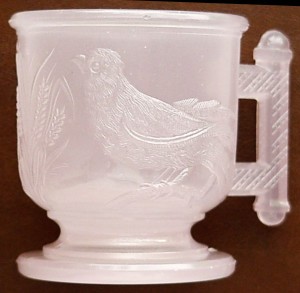
Several sizes of the Hen-on-Nest dish were made by Atterbury. Most of them are found in white milk glass with red glass eyes, but other colors were also made. The Atterbury hen dishes were probably made from the 1880s up until their closure circa 1902. Similar hen dishes were made in later years including pieces produced by Westmoreland Glass Company and Fenton Art Glass Company.
Also very important was their line of elegant oil lamps (pressed and blown). Large quantities of milk glass compotes and “lacy edge” baskets were produced. Some of the lacy-edge bowls or baskets could be made to serve double-duty – they could be used “as is” (with no cover) or as a base for a covered dish, for instance, the “two entwined fishes” dish.
(Another noted glass manufacturer in the Pittsburgh area was Challinor, Taylor & Company, a direct competitor of Atterbury, which also made a specialty of milk glass and slag glass compotes, hen-on-nest dishes and other EAPG — Early American Pattern Glass — tableware in various colors.)
Many of the tableware and novelty items produced by Atterbury were marked with patent dates on the base, but in general they are not marked with the firm name or initials.
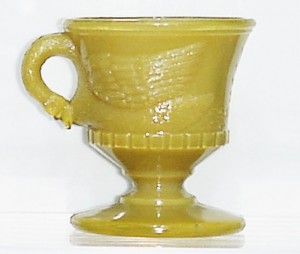
Because I’m especially interested in the children’s mugs they produced, I will devote most of this particular page to those pieces. Atterbury produced a line of mugs (some, if not most, are said to have been intended as “children’s mugs” although that may or may not be entirely true) in a wide variety of colors, including opaque, alabaster, and transparent colored glass.
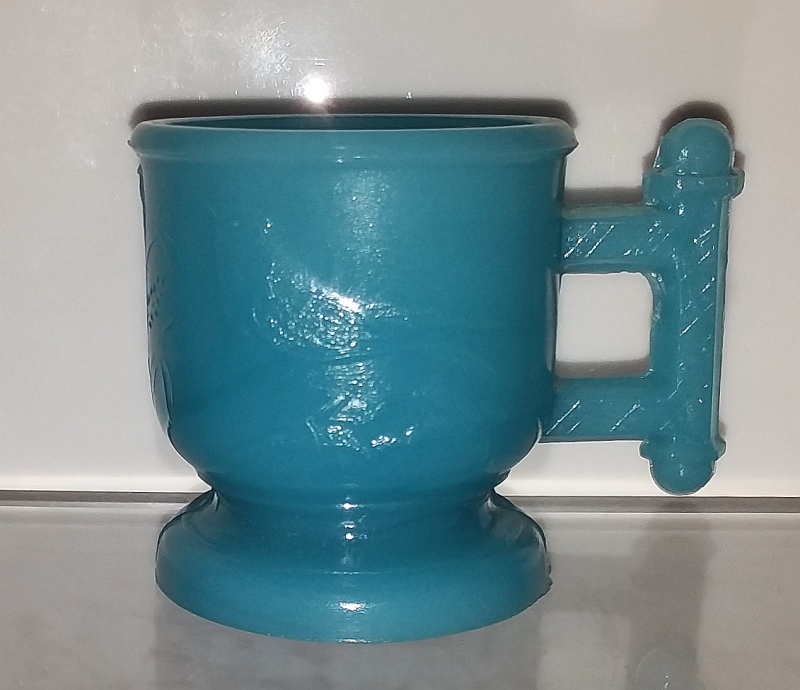
Several examples are shown on this page of the Eastlake pattern mug, sometimes called Robin, Robin & Wheat or Bird & Wheat by present-day collectors. One example (shown near the top of this page) is made of a semi-opaque pink glass. There are several slightly different shades/intensities of that color, variously called translucent pink, pink alabaster or pink clambroth by collectors. Other colors shown here include amber and two shades of opaque blue.

Other colors seen in the Eastlake mugs include a medium sapphire blue, turquoise blue, cobalt blue, amethyst alabaster, opaque green, clambroth, opaque pink milk glass, opaque raspberry, blue alabaster, white milk glass, orange amber, olive amber, opaque butterscotch or mustard, dull olive green alabaster, chartreuse, citrine or citron (similar to canary yellow but with a greenish tint), chocolate brown alabaster, clear, and black glass.
The original factory pattern name was indeed Eastlake, as shown by a listing in an early Atterbury catalog published circa 1881. Eastlake was produced in four different “regular” sizes (No. 1, No. 2, No. 3 and No.4 sizes) plus a heavier, somewhat differently styled compartmented “Shaving Mug” which is not footed. The interior of that type of mug has two sections, one shallow and the other deeper, separated by a vertical “wall” of glass. Illustrated is an example in white milk glass (opaque white or “opal”). In this piece, the white is an absolute “dead white” with not even a hint of translucency …… it is completely opaque!
The unusual Victorian-style handle on these mugs is quite attractive with a hexagon-shaped cross-section. The general “look” of the handle, featuring a series of diagonal lines, has been compared by some collectors as vaguely reminiscent of the old-fashioned barber shop pole. Other colors known in the Eastlake shaving mug version include amber, blue alabaster and pink alabaster. Probably other colors exist!

As far as the “No. 3” size mug is concerned (which is the most common size – about 3 and 1/2 inches in height and 4 inches in diameter including handle), there were at least four different molds used. The molds can be told apart by slight, but easily noticeable differences in the details of the design. There are two molds in the “slightly cupped base” variant, and 2 molds of the “flat base” variant. In one of the molds of the “flat base” type, a defining characteristic of the mold is that (with the handle oriented toward the left) and looking straight at the bird (which is facing to the right), the upper, over-arching narrow pointed leaf extends rather far underneath/past the birds beak, and gets very close (but doesn’t quite touch) the bird’s upper breast area. This is the easiest and quickest way to differentiate between the two “flat base” molds, because on the other mold, that same leaf isn’t as close to the bird and doesn’t extend past the bird’s beak.
ADVERTISEMENT
The exact timeline when the Eastlake mugs were being made is not known, although, as mentioned above, they were shown in an Atterbury catalog that was issued circa 1881. Presumably the mugs were produced for at least several years afterward. (Incidentally, the mid-1880s, especially 1885-1888, is a time when colored glass tableware was VERY popular with the buying public, including blue, amber, canary, apple green and other colors. )
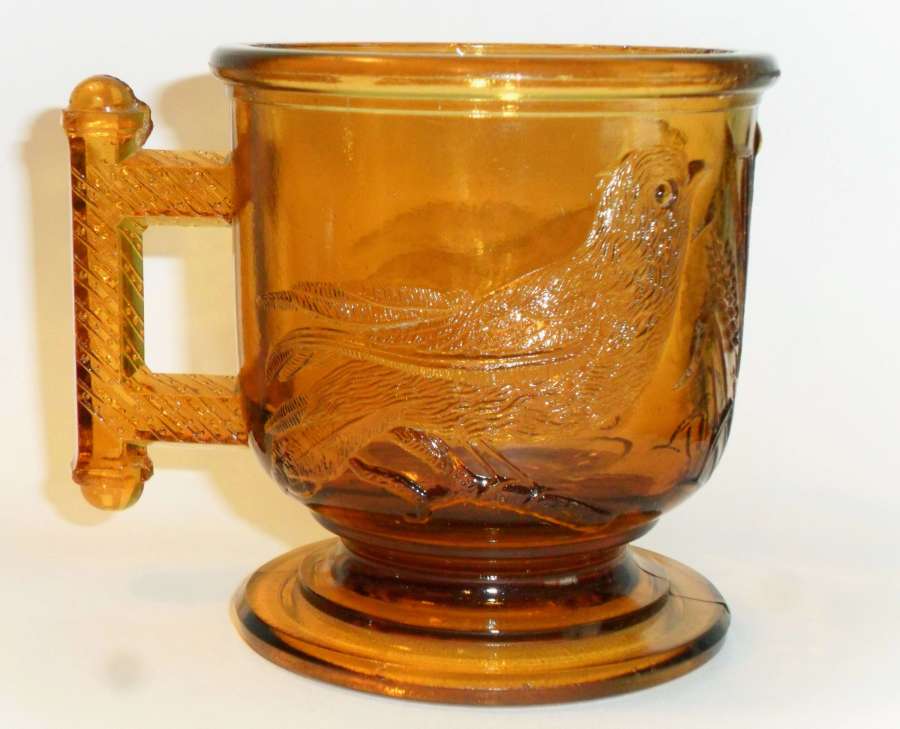
According to Jay Hawkins, Atterbury was still producing “fancy colored and opal ware” as mentioned on a business letterhead from c. 1901. I see no reason to assume that Atterbury did not continue to make the Eastlake mug, and probably some of their other mugs, into the mid-1890s, since they were evidently good sellers. The fact that they have been found in so many different colors, and were made in a number of different molds, points to the probability of them having been in production over a long period of time. However, there appears to be no documentation (catalogs, production records, etc) still around that would give us concrete evidence on how late these mugs were made.
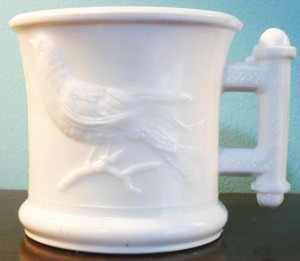
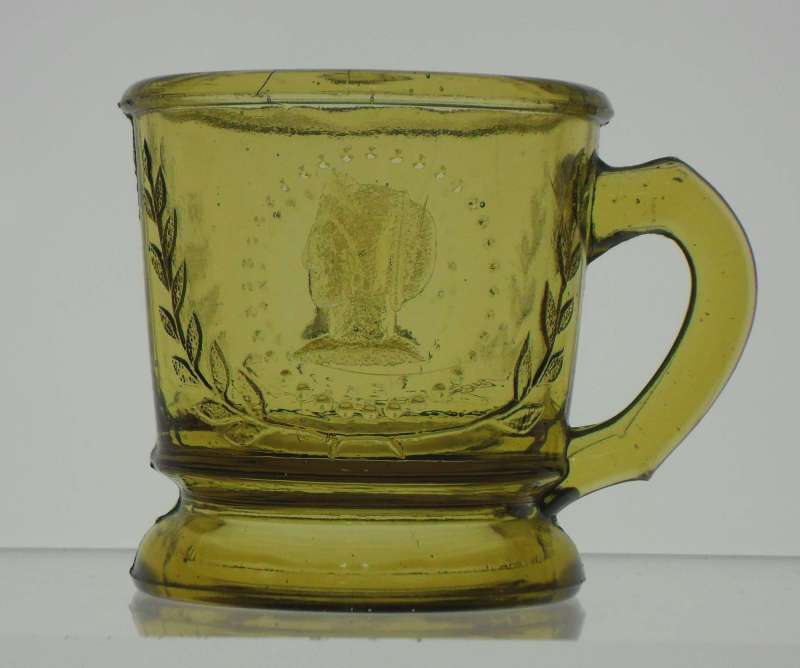
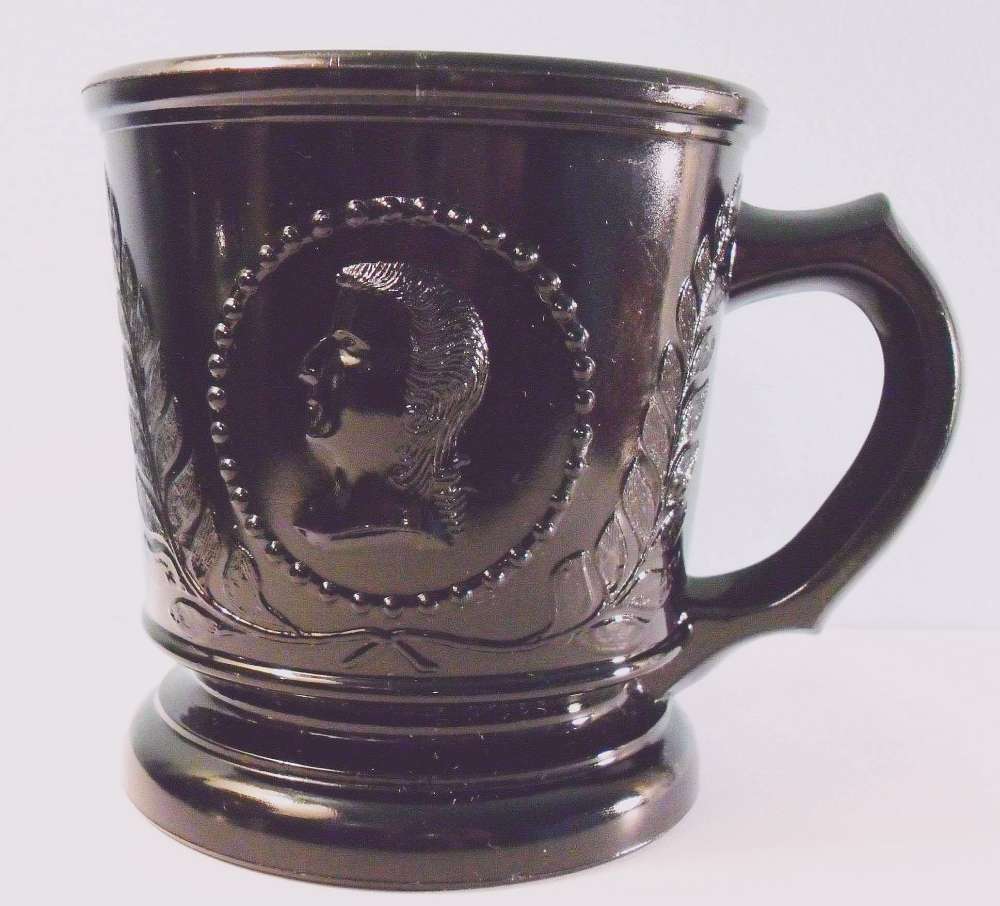
Other mugs produced by Atterbury include Medallion (also known as “Ceres“or “Cameo“) and Leaf. Three different styles of “Swan” mugs are believed to be Atterbury products, including Swan with Ring Handle, Swimming Swan Variant #1, and Swimming Swan #2). Several other mugs are also believed to have been made by Atterbury, (judging from the range of colors they have been reported in) but there is a lack of catalog listings or other 100% solid documentation to back up those attributions. This includes Crossed Cords & Prisms, Owl & Horseshoe, and Mephistopheles (the variant with an identical handle to the Ceres mugs). The Owl & Horseshoe mug has a handle virtually identical to the one on Eastlake.
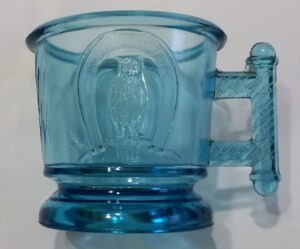
The “Swan with Ring Handle” is also seen in several other forms besides mugs. Below, a double-ring handle pattern in what has been termed a “Mustard” (Alice Hulett Metz, Much More Early American Pattern Glass, 1965, page 86, catalogued as item #1028″ in clear glass), a sugar bowl, or a double-handled mug.
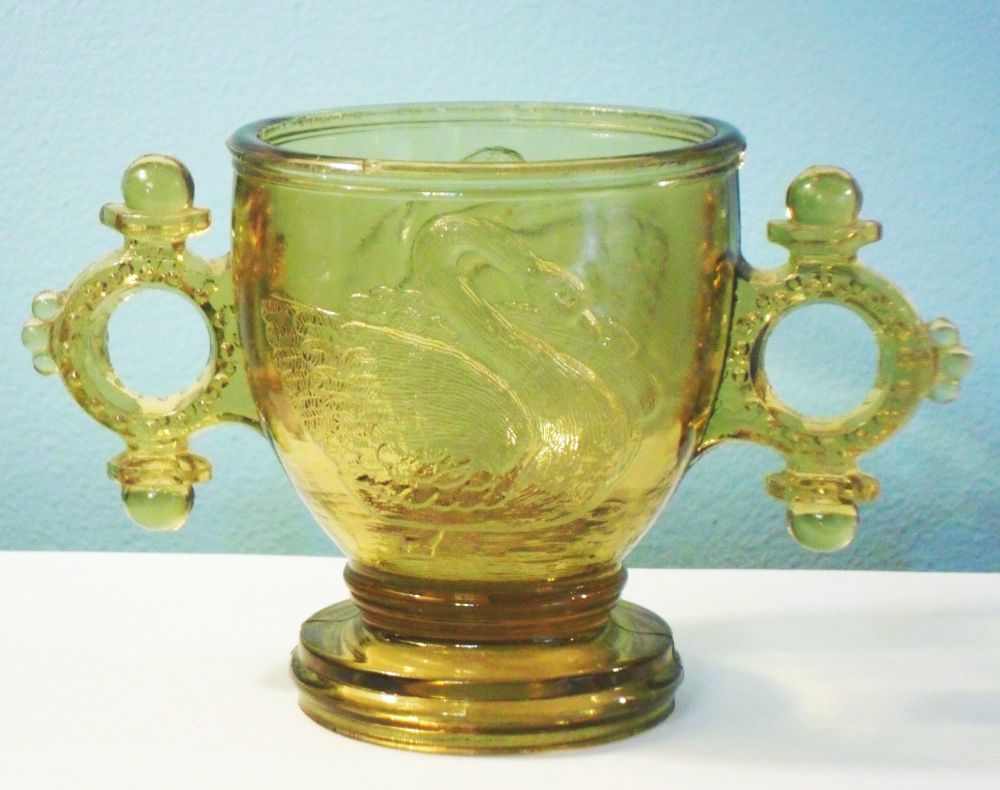
PAT’D APR 23, ’78
This marking is seen on the bottom of a variety of tableware items, all made by Atterbury & Company. The patent date (April 23, 1878), refers to a design (Design #10,643),which was awarded to Thomas B. Atterbury of Pittsburg(h). The patent was in effect for 3 and 1/2 years. Presumably, though it is impossible to be absolutely certain, most of these pieces with the ’78’ patent marking were likely made in the period of 1878 to 1882. The design features elements of a melon (canteloupe or muskmelon-type appearance) with convex “fluting” or “sections” and a netting background texture, often accompanied by a leaf or leaves motif. Sometimes the leaf itself is the central motif (as on the mug). This pattern has been described under a number of different names, including Melon (there is also an earlier Melon pattern with NO webbing, under a separate 1870 patent), Melon with Leaf, Melon with Leaf and Net, Leaf, Paneled Fern, and occasionally (incorrectly) Acanthus. The most common and recognized form is the “compote” or “butter dish” in the shape of a melon lying horizontally, with a smaller “melon” or fruit- shaped finial (handle) on the top. (This piece has been reproduced by L. E. Smith Glass Company, in several colors not seen in the originals. If I understand correctly, none of the reproductions have the 1878 patent marking on the bottom).
Other pieces that are occasionally encountered include the spooner, creamer, covered sugar bowl and mug. The mug has only a “leaf” design but without a background pattern of “netting” or “webbing” as seen on the other pieces. This leaf pattern mug is shown on page 26 of the Glass Collector’s Digest (April/May 1989 issue) in the article on Atterbury mugs written by G. Eason Eige. The “leaf dish” sometimes attributed to Hemingray might be related to this pattern, as the patent drawings do show a dish or shallow plate although the exact design is not the same.
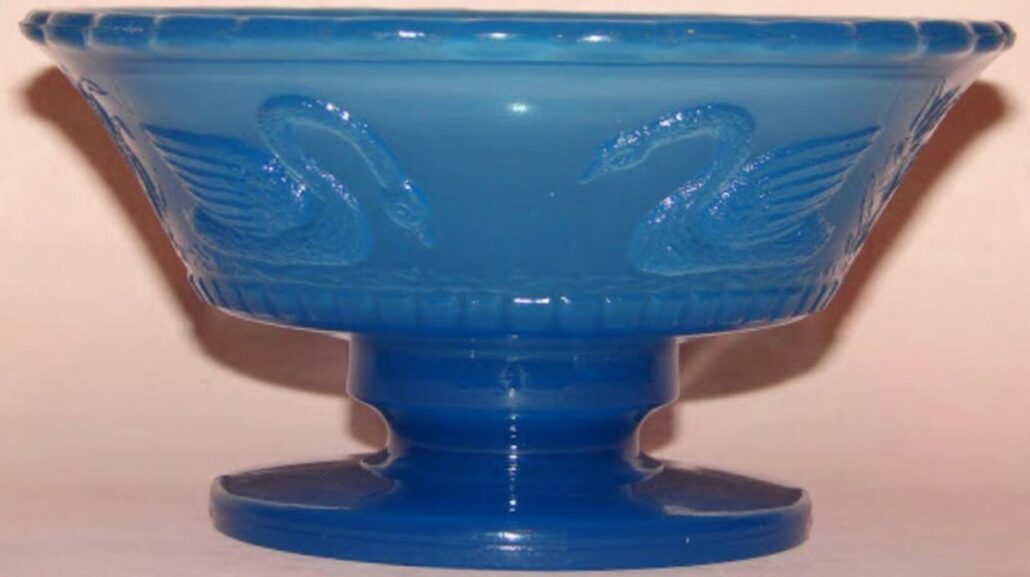
ADVERTISEMENT
The “Melon w/ leaf” pieces have been seen in clear, white milk glass and transparent blue. The Leaf mugs have been seen in clear, white milk glass, amber and an odd mousy gray-brown, which is shown in the magazine article referenced above. Other colors (of the mugs) may exist, but all of the leaf mugs are very hard to find.
Click here for a brief article on EAPG (Early American Pattern Glass).
Please click here to go to my website Home Page.
For an extensive list of glass manufacturers’ marks seen on bottles, jars, tableware and other items, please click here to go the Glass Bottle Marks pages (page one).
Check out my webpage about MILK GLASS: Collectible Milk Glass – General Information & Overview
Here is a keyword search on the Ebay.com auction site for Atterbury glass:
ADVERTISEMENT

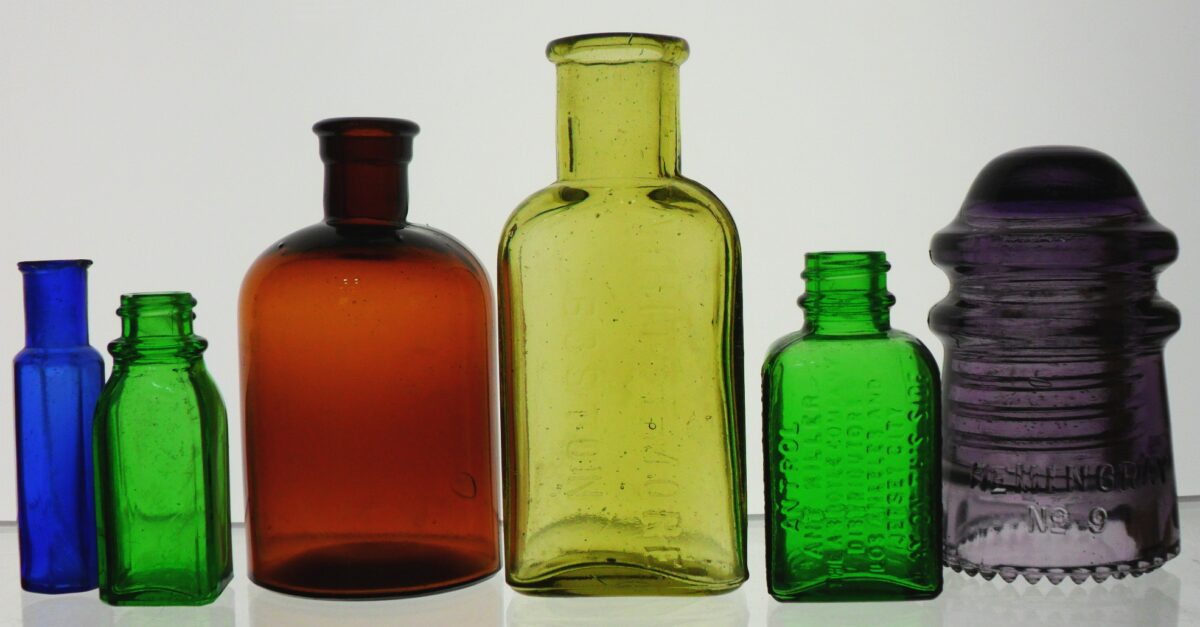
I have a raised wing swan listed on the 1 inch base which is beyond rare and no interest is shown in it. Does the public not know the difference in the 2 versions?
Hi William,
Can you please check my “Contact Information” page and send me an email with pictures of that piece attached? I’m not sure which item you are referring to. THANK YOU and best regards,
~David
I am looking to understand Atterbury Milk Glass Fish plate that had on the bottom “Pat – Pending.
Rene, I am under the impression that the fish plates marked “PAT PENDING” were made sometime before the fish dishes that bear the June 4, 1872 patent date on the bottom. If anyone has better information on this, please chime in on this thread!
Thanks, David
My Mom passed away a little over a year ago at 95. She had an entwined fish white milk glass bowl with lid. I always liked it so I kept it. I just unpacked it. There are no markings at all. I am assuming it is still Atterbury. Do you have any information. Also appears to have grey lines throughout the outside of the bowl.
Hello Linn,
Condolences on the loss of your mother. I was under the impression that ALL of the known examples of the white milk glass “Entwined Fish” dishes made by Atterbury are marked “PATd Aug. 1889” on the underside of the lid. I was not aware they have been reproduced. Perhaps a reader has better information for us?
Also, some milk glass items made by Atterbury are found with imperfections or streaks of lighter or darker color in the glass. For instance, a pitcher I own has small specks of a black or gray impurity embedded in the otherwise white glass. I suppose this was fairly common in their opaque glassware, as they are known to have made very large quantities of some items and evidently in their haste to produce lots of glassware they didn’t always have the absolute best quality control.
Thanks for posting!
David
I an looking for information on some glass items that I have with the capital A and Eagle mark Like the Anheuser – Busch LOGO. If you can help it would be greatly appreciated. Thank you
Jim Buell
The A and Eagle is the mark for Akro Agate. They made marbles (I think they were the largest manufacturer of marbles in the world) and during the 1930s the company began to manufacture ashtrays and small glass containers and soon added flowerpots and children’s dishes.
Hi Jennie,
Thanks for your post. Just one minor correction………. the bird is actually supposed to be a Crow (A CROW, a play on the company name) although most collectors, myself included, would assume it is an eagle or similar large bird. I have this mark listed on page one under the “A” listings.
Take care,
David